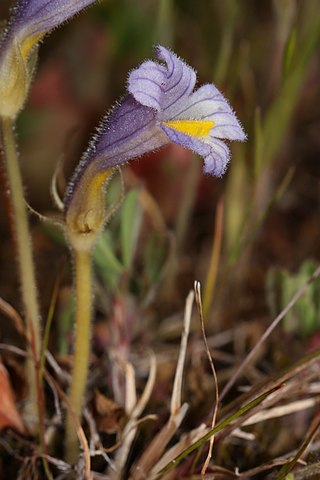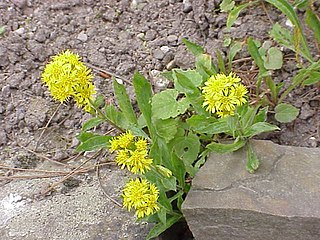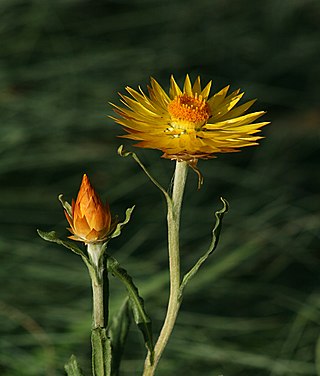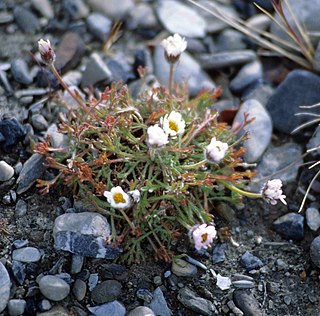
Calamagrostis is a genus of flowering plants in the grass family Poaceae, with about 260 species that occur mainly in temperate regions of the globe. Towards equatorial latitudes, species of Calamagrostis generally occur at higher elevations. These tufted perennials usually have hairless narrow leaves. The ligules are usually blunt. The inflorescence forms a panicle. Some may be reed-like.

Alisma is a genus of flowering plants in the family Alismataceae, members of which are commonly known as water-plantains. The genus consists of aquatic plants with leaves either floating or submerged, found in a variety of still water habitats around the world. The flowers are hermaphrodite, and are arranged in panicles, racemes, or umbels. Alisma flowers have six stamens, numerous free carpels in a single whorl, each with 1 ovule, and subventral styles. The fruit is an achene with a short beak.

Orobanche, commonly known as broomrape, is a genus of over 200 species of small parasitic herbaceous plants, mostly native to the temperate Northern Hemisphere. It is the type genus of the broomrape family Orobanchaceae.

Solidago virgaurea, the European goldenrod or woundwort, is an herbaceous perennial plant of the family Asteraceae. It is widespread across most of Europe as well as North Africa and northern, central, and southwestern Asia. It is grown as a garden flower with many different cultivars. It flowers profusely in late summer.

Xerochrysum is a genus of flowering plants native to Australia. It was defined by Russian botanist Nikolai Tzvelev in 1990, preceding Bracteantha which was described the following year. A 2002 molecular study of the tribe Gnaphalieae has indicated the genus is probably polyphyletic, with X. bracteatum and X. viscosum quite removed from each other.

Achnatherum is a genus of plants which includes several species of needlegrass. Several needlegrass species have been switched between Achnatherum and genus Stipa; taxonomy between the two closely related genera is still uncertain.

Elymus is a genus of perennial plants with approximately 150 species in the grass family, related to rye, wheat, and other widely grown cereal grains.
Knorringia is a genus of plants in the family Polygonaceae. It is native to Central Asia and Siberia.

Anthemideae is a tribe of flowering plants in the family, Asteraceae, and the subfamily Asteroideae. They are distributed worldwide with concentrations in central Asia, the Mediterranean Basin, and southern Africa. Most species of plant known as chamomile belong to genera of this tribe.
Australopyrum is a genus of plants in the grass family, native to Australia, New Zealand, and New Guinea.

Ajania is a genus of flowering plants in the daisy family, described as a genus in 1955. The genus is native to temperate Asia, primarily Russia and China. It is named after the Russian port city Ayan in the Khabarovsk Krai region of the Russian Far East, on the coast of the Sea of Okhotsk.
Pseudohandelia is a genus of flowering plants in the chamomile tribe within the daisy family.

Arctanthemum is a genus of flowering plants in the daisy family.

Laphangium is a genus of plants in the family Asteraceae.
Hyalopoa is a genus of Asian plants in the grass family.

Stipa zalesskii is a grass found in Europe and Asia. It is an important grass in Eurasian steppe. Its culms are 30–75 cm long and the leaf-blades 20–35 cm long by 0.6–1 mm wide.
Ranunculus propinquus is a species of flowering plant belonging to the family Ranunculaceae.
Najas tenuissima is a species of flowering plant belonging to the family Hydrocharitaceae.
Tanacetopsis is a genus of flowering plants belonging to the family Asteraceae.
Minuartia krascheninnikovii is a species of flowering plant in the sandwort genus Minuartia, family Caryophyllaceae, native to East European Russia. It is found in the petrophytic steppes of the southern Ural mountains.











